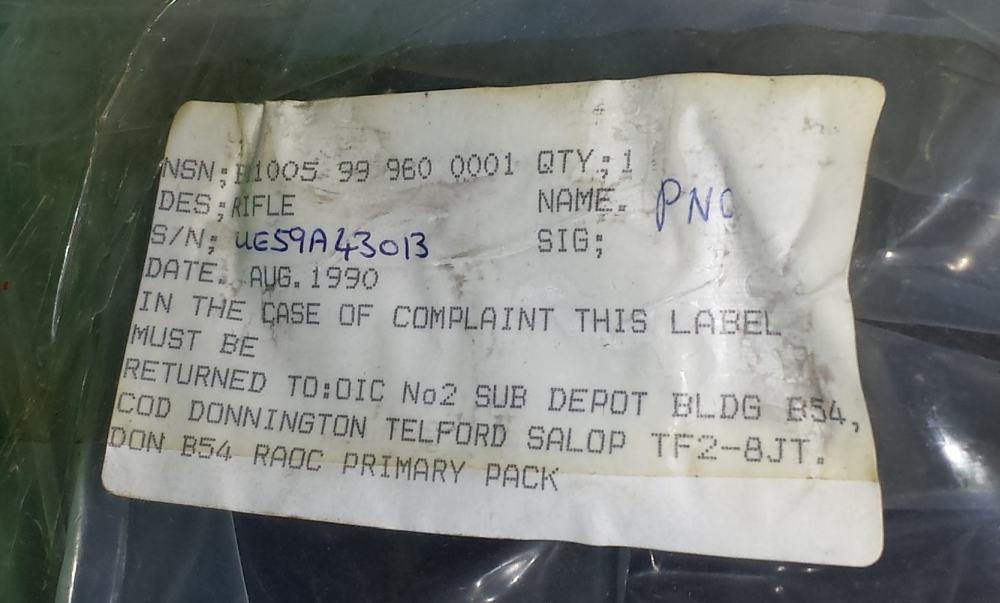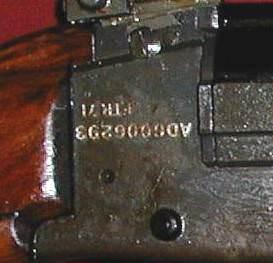-
Legacy Member

Rebuilt British L1A1s--how marked?
I have seen several pictures of British L1A1s that appear to have been rebuilt for war reserve before being sold off in Europe, and a number of TMH assemblies in America that look to have been rebuilt at least once in the past. However, among these I can only recall seeing one example (a TMH in America) that appeared to have FTR markings.
L1A1s that appear to have been rebuilt for war reserve before being sold off in Europe, and a number of TMH assemblies in America that look to have been rebuilt at least once in the past. However, among these I can only recall seeing one example (a TMH in America) that appeared to have FTR markings.
Was there a marking protocol for FTR or base workshop rebuilt L1A1s in British service?
Information
 |
Warning: This is a relatively older thread
This discussion is older than 360 days. Some information contained in it may no longer be current. |
|
-
-
04-27-2021 05:08 PM
# ADS
Friends and Sponsors

-
Contributing Member


While we wait for the knowledgeable to pitch in, I have seen a couple of rifles marked with a discreet FTR on the TMH, but these were service reworked (in house, or contractor, I don't know), this would have been carried out and so marked, in the 1970's I would assume?
But I don't think rifles refurbished for war reserve were marked with FTR in the late 1980's or early 1990's... Never seen one anyway.
Refurbished at considerable cost by Parker Hale .... Then sold for peanuts!
-
-
-
Legacy Member

Interesting.
In my time as an armourer I don't recall ever seeing 'FTR' on an L1A1, not to say that it didn't happen.
We certainly saw a high turnover of rifles, the replacements being base workshop refurbishments, in BAOR anyway.
Unlike the Lee Enfield No 4 Mk1 and 1*'s that underwent FTR, which effectively upgraded them to different models, Mk1/2 and Mk1/3, the L1A1 refurbishment din't fundamentally change the weapon it only brought them back up to original spec.
-
Thank You to BigBadDog For This Useful Post:
-
Legacy Member

Speak of the devil...look what showed up in my email this morning...go to the eighteenth picture:
DSA SA58 FAL L1A1 Type 1 Early DS .308 7.62mm Trilux Aussie UK - Semi Auto Rifles at GunBroker.com : 899528753
Perhaps my question is more correctly "were L1A1 rebuilds mostly done at base workshops or other non "factory" facilities (therefore not a true 'FTR'?), and if so, were they normally marked in any way?"
-
-
Legacy Member

Thank you for posting link. Learn something new every day. I would guess that most rebuilds would have been done at base workshop in BAOR or at the Workshops in Warminster, sorry can’t remember names or numbers, though no evidence to support this.
The FTR engraving looks very similar, in depth, style etc to the numbering which would of have been done at manufacture, doesn’t explain anything though. On Enfields the FTR mark was usually identifiably different to the original manufacturers markings, does not prove anything in this case though. On the L1A1 the master number was on the body.
A couple of unsolicited observations re this rifle, based on the photos.
The body hinge pin is in backwards, is this affecting the safety function of the weapon?
The pin for the flesh eliminator key is missing. Is the flash eliminator fitted correctly?
Hand guard screw in backwards, for a British weapon any way, might explain cracked hand guards.
weapon any way, might explain cracked hand guards.
Needs a dam good clean, with this level of care what else has the owner neglected to do?
The breech block should be serial numbered to the rifle, I am unable to see any number at all.
The serial number on the carrier does not match anything.
Whilst the add does say it is a build up from various bits, the lack of matching serial numbers is a real big red ***. Gauging will be critical to ensure safety prior to any firing. Good bargaining chip.
From the photos I would say that this rifle has been assembled by someone who really doesn’t know what they are doing or doesn’t care.
-
-
Contributing Member



Originally Posted by
BigBadDog

Interesting.
In my time as an armourer I don't recall ever seeing 'FTR' on an L1A1, not to say that it didn't happen.
We certainly saw a high turnover of rifles, the replacements being base workshop refurbishments, in BAOR anyway.
Unlike the Lee Enfield No 4 Mk1 and 1*'s that underwent FTR, which effectively upgraded them to different models, Mk1/2 and Mk1/3, the L1A1 refurbishment din't fundamentally change the weapon it only brought them back up to original spec.
I'm stirring the old grey matter to remember the rifles I saw FTR marked.
The OP mentioned the small FTR on the TMH and that's what rang a bell with me. I'm 90% sure they were British BSA manufacture rifles, but it was 10 years ago now.
BSA manufacture rifles, but it was 10 years ago now.
The problem with these questions is they often only lead to even more questions!
Did BSA ever carry out an L1A1
re-furbishment programme, perhaps for onward sale?
Could the FTR markings be specific to replacing / re-furbishment of the TMH?
The only private contractor I'm aware of is Parker Hale, who carried out an in depth rebuild of thousands of rifles towards the end of their service lives.
Unfortunately, while information regarding inch pattern contracts is widely available, with Australian rifles (the Canadians not selling or gifting any numbers to foreign players), information regarding British rifles (foreign sales/ gifting) is very patchy and largely second hand in nature.
rifles (the Canadians not selling or gifting any numbers to foreign players), information regarding British rifles (foreign sales/ gifting) is very patchy and largely second hand in nature.
Re the No4, MK1 rifles were refurbished as MK1's post war and FTR marked, as part of the huge No4 stockpile overhaul.
Last edited by mrclark303; 04-29-2021 at 03:56 AM.
-
-
Legacy Member

I can state that the war reserve refurbishments WEREN'T 'FTR', in fact the refurbishment is sketchy to say the lest (I have two of them) The rifles were full of Australian parts, there are cracks in the top cover and it looks like someone spray painted the metal parts of handguards as you can see the over spray. on the Nylon 66.
parts, there are cracks in the top cover and it looks like someone spray painted the metal parts of handguards as you can see the over spray. on the Nylon 66.
FTR has one meaning only Factory Thorough Repair, where the rifle was returned to the factory to be gauged and rebuilt to 'New Standard', this could mean the replacement of bodies, TMH, Barrel Assemblies and anything else that needs replacement to ensure its within 'Factory New' Specs.
There were overhaul programs within the defence forces at Base Workshops, where they would rebuilt the rifles, replacing components and ensuring the rifle meets the standards set down in EMER D118. They could replace barrels and in New Zealand they also replaced Bodies, but at the end of it, the rifles would meet EMER D118 or EMEI D258 (Australian) standards. They weren't marked unless a modification called for it, they just looked very pretty. In the last year of L1A1 use in New Zealand 1 Base Workshops was overhauling 100 rifles a week IIRC



Australian FTR Marking

Last edited by nzl1a1collector; 04-30-2021 at 07:55 PM.
Reason: thorough
-
-
-
-
Legacy Member

I think your right, I think Ive seen the marking your referring too, but cant find the image. Not sure what it means and would have to look at it in context to the whole of the rifle. The FTR marking, as it is on the SMLE/No.4/Bren etc was no small feat. The weapon came out of the Factory 'As New', presumably for less than the cost of a new rifle. Generally you will find only early rifles were FTR, because of issues with Bodies being 'soft' or 'stretching' in very basic terms. In British service as Peter L has pointed out the past where the body needed to be replaced, it was a factory job. Although there are clear instructions on how to replace and mate up the body and barrel in the REME instructions, if you had the correct fixtures at a Base Workshops. At this stage Ive only found one Enfield FTR Date and that's 1967, for Australia
service as Peter L has pointed out the past where the body needed to be replaced, it was a factory job. Although there are clear instructions on how to replace and mate up the body and barrel in the REME instructions, if you had the correct fixtures at a Base Workshops. At this stage Ive only found one Enfield FTR Date and that's 1967, for Australia Ive been 1967. I know Lithgow Museum have Ledgers that detail those rifles that have come through their FTR programs. The original s/n details are crossed out and a reference is put in to the FTR ledger. I would think Enfield and BSA would also have s/n ledgers.... I wonder what happened to those?..... Someone please find them!
Ive been 1967. I know Lithgow Museum have Ledgers that detail those rifles that have come through their FTR programs. The original s/n details are crossed out and a reference is put in to the FTR ledger. I would think Enfield and BSA would also have s/n ledgers.... I wonder what happened to those?..... Someone please find them!
-
-
Legacy Member


Originally Posted by
mrclark303

Could the FTR markings be specific to replacing / re-furbishment of the TMH?
On that front, I have what's clearly a replacement TMH (UB58 serial number on a 1966 Enfield TMH) and it has no non-standard markings at all...not even the little "4" and "7" upgrade marks on the stock tang.
Looks like it was a brand new TMH...no evidence of a removed serial number, just a nice deep number that's polar opposite from the shallow markings that seemed common to BSA-made rifles.
-
L1A1s that appear to have been rebuilt for war reserve before being sold off in Europe, and a number of TMH assemblies in America that look to have been rebuilt at least once in the past. However, among these I can only recall seeing one example (a TMH in America) that appeared to have FTR markings.















 PM
PM














